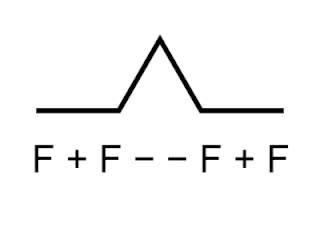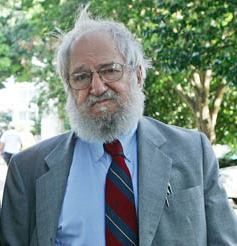
Logo is an educational programming language, designed in 1967 by Wally Feurzeig, Seymour Papert, and Cynthia Solomon. Logo is not an acronym: the name was coined by Feurzeig while he was at Bolt, Beranek and Newman, and derives from the Greek logos, meaning word or thought.

Seymour Aubrey Papert was a South African-born American mathematician, computer scientist, and educator, who spent most of his career teaching and researching at MIT. He was one of the pioneers of artificial intelligence, and of the constructionist movement in education. He was co-inventor, with Wally Feurzeig and Cynthia Solomon, of the Logo programming language.

The MIT Media Lab is a research laboratory at the Massachusetts Institute of Technology, growing out of MIT's Architecture Machine Group in the School of Architecture. Its research does not restrict to fixed academic disciplines, but draws from technology, media, science, art, and design. As of 2014, Media lab's research groups include neurobiology, biologically inspired fabrication, socially engaging robots, emotive computing, bionics, and hyperinstruments.

William Gaston Caperton III is an American politician who served as the 31st Governor of West Virginia from 1989 to 1997. He was president of the College Board, which administers the nationally recognized SAT and AP tests, from 1999 to 2012. He is a member of the Democratic Party.

Constructionist learning is the creation by learners of mental models to understand the world around them. Constructionism advocates student-centered, discovery learning where students use what they already know, to acquire more knowledge. Students learn through participation in project-based learning where they make connections between different ideas and areas of knowledge facilitated by the teacher through coaching rather than using lectures or step-by-step guidance. Further, constructionism holds that learning can happen most effectively when people are active in making tangible objects in the real world. In this sense, constructionism is connected with experiential learning and builds on Jean Piaget's epistemological theory of constructivism.
Networked learning is a process of developing and maintaining connections with people and information, and communicating in such a way so as to support one another's learning. The central term in this definition is connections. It adopts a relational stance in which learning takes place both in relation to others and in relation to learning resources. In design and practice, networked learning is intended to facilitate evolving sets of connections between learners and their interpersonal communities, knowledge contexts, and digital technologies.
Etoys is a child-friendly computer environment and object-oriented prototype-based programming language for use in education.
Globaloria is an online learning platform oriented to K-12 curricula to teach students to design, prototype, and code educational web/mobile games and simulations with industry-standard technology as a means of learning content and creative innovation skills. Globaloria was developed in 2006 by Idit Harel as a project of the World Wide Workshop Foundation with the stated mission of providing all primary and secondary school students in the U.S. with STEM and computing education opportunities. Globaloria is noteworthy among MOOCs as it is based in constructionist learning theory and Harel's research in the MIT Media Lab.
MaMaMedia was an educational consulting firm run by Idit Harel Caperton, specializing in applications of constructionist learning theory.
MicroWorlds JR is a computer program using a simplified version of the Logo programming language to teach non-readers or early readers to program in Logo. It was first launched in 2004 by Logo Computer Systems, Inc. (LCSI), and as in their original line of MicroWorlds programs, the object on the screen begins as a turtle and can be controlled with basic commands to make it move. Differing from the Logo syntax developed by Seymour Papert and teams at MIT, MicroWorlds JR uses images to replace the command names, which are selected by the child to create turtle graphics. The turtle object can be given a variety of shapes that act as a costume for the turtle, and therefore lends itself to a variety of animations and creative stories and projects for younger students.
Computational thinking (CT) refers to the thought processes involved in formulating problems so their solutions can be represented as computational steps and algorithms. In education, CT is a set of problem-solving methods that involve expressing problems and their solutions in ways that a computer could also execute. It involves automation of processes, but also using computing to explore, analyze, and understand processes.
SEED, also known as Schlumberger Excellence in Educational Development, is a global non-profit educational outreach organization within Schlumberger Limited, the global oilfield services company.

Yasmin B. Kafai is a German American academic who is Professor of Learning Sciences at the University of Pennsylvania Graduate School of Education, with a secondary appointment in Computer and Information Sciences at University of Pennsylvania School of Engineering and Applied Science. She is a past president of the International Society of the Learning Sciences (ISLS), and an executive editor of the Journal of the Learning Sciences.

Cynthia Solomon is an American computer scientist known for her work in popularizing computer science for students. She is a pioneer in the fields of computer science, and educational computing. While working as a researcher at Massachusetts Institute of Technology (MIT), Solomon took it upon herself to understand and program in the programming language Lisp. As she began learning this language, she realized the need for a programming language that was more accessible and understandable for children. Throughout her research studies in education, Solomon worked full-time as a computer teacher in elementary and secondary schools. Her work has mainly focused on research on human-computer interaction and children as designers. While working at Bolt, Beranek and Newman, she worked with Wally Feurzeig and Seymour Papert, to create the first programming language for children, named Logo. The language was created to teach concepts of programming related to Lisp. Solomon has attained many accomplishments in her life such as being the vice president of R&D for Logo Computer Systems, Inc., when Apple Logo was developed and was the Director of the Atari Cambridge Research Laboratory. Solomon worked on the program committee of Constructing Modern Knowledge and the Marvin Minsky Institute for Artificial Intelligence in 2016. Further, she has published many writings based on research in the field of child education and technology in the classroom. Solomon has conducted workshops in elementary schools, high schools, and colleges regarding academic research and writing. She continues to contribute to the field by speaking at conferences and working with the One Laptop per Child Foundation.

Edith K. Ackermann was a Swiss-born American psychologist who explored the interactions between developmental psychology, play, learning and design. A graduate of the University of Geneva, and a protege to Jean Piaget, she held permanent and visiting positions at several institutions in the United States and Europe, including the MIT Media Lab.
Sylvia Weir (1925–2018) was a paediatrician who worked on artificial intelligence. She pioneered the use of robotics in autism therapy.

Jeanne Bamberger is the American Professor Emerita of Music and Urban Education at the Massachusetts Institute of Technology, and Adjunct Professor of Music at the University of California, Berkeley. Her research interests include music cognitive development, music theory and performance, teacher development, and the design of text and software materials that foster these areas of development.

Turtlestitch is a free and open source platform for generating and sharing patterns for embroidery machines. Turtlestitch is derived from educational programming languages such as Logo, Scratch and Snap! using the same jigsaw style programming paradigm which offers simplicity suitable for novices but has powerful features, described as ‘low threshold, high ceiling’ by Seymour Papert. Its microworld is a turtle representing the needle of a programmable embroidery machine. Turtlestitch can be used for creating novel patterns for embroidery, combining the abstract logic of computing and the physical materiality of textiles. Its primary use is educational, as it offers a way of introducing programming to audiences with diverse interests. A growing gallery of open source embroidery designs enables community-based collaboration and shared learning. In 2017, Turtlestitch received the award for the best Open Educational Resource in the German-speaking countries.
Marina Umaschi Bers is the Augustus Long Professor of Education at Boston College. Bers holds a secondary appointment in Boston College's Department of Computer Science. Bers directs the interdisciplinary DevTech Research Group, which she started in 2001 at Tufts University. Her research involves the design and study of innovative learning technologies to promote children's positive development. She is known for her work in the field of early childhood computer science with projects of national and international visibility. Bers is the co-creator of the free ScratchJr programming language, used by 35 million children, and the creator of the KIBO robotic kit, which has no screens or keyboards.

Alexei L. Semenov is a Russian mathematician, educationalist, Academician of the Russian Academy of Sciences, Academician of the Russian Academy of Education, Head of the Department of Mathematical Logic and Theory of Algorithms, Lomonosov State University, Professor, and Dr. Sc.











